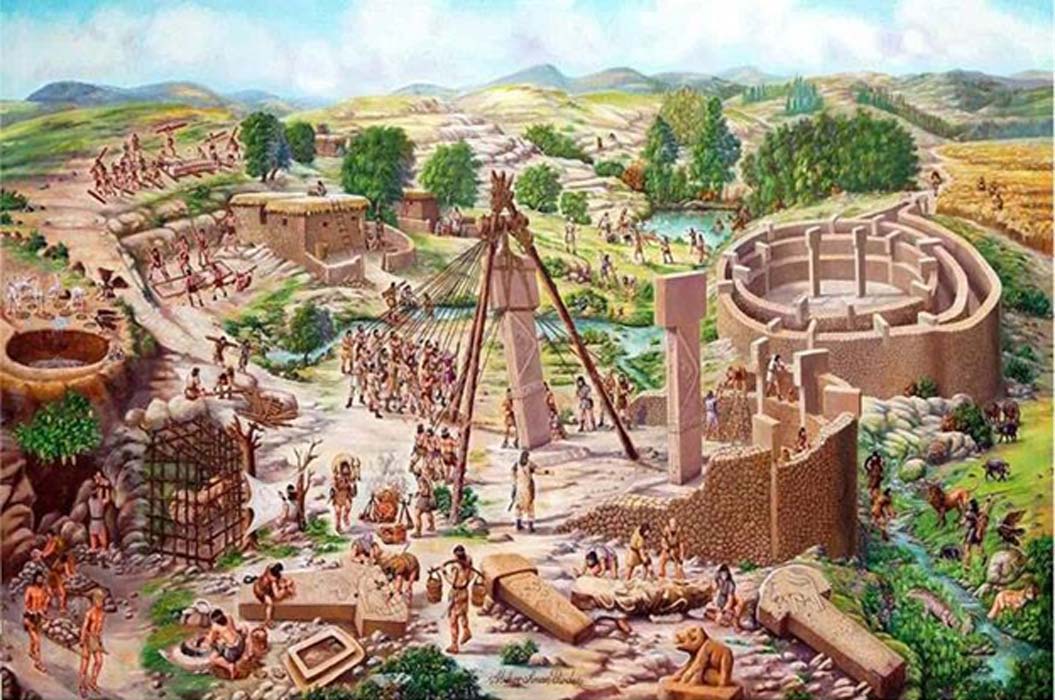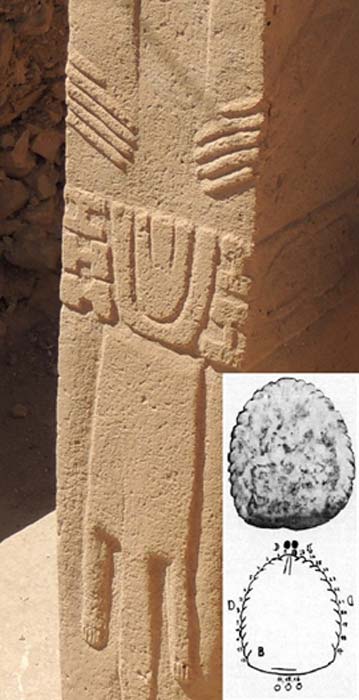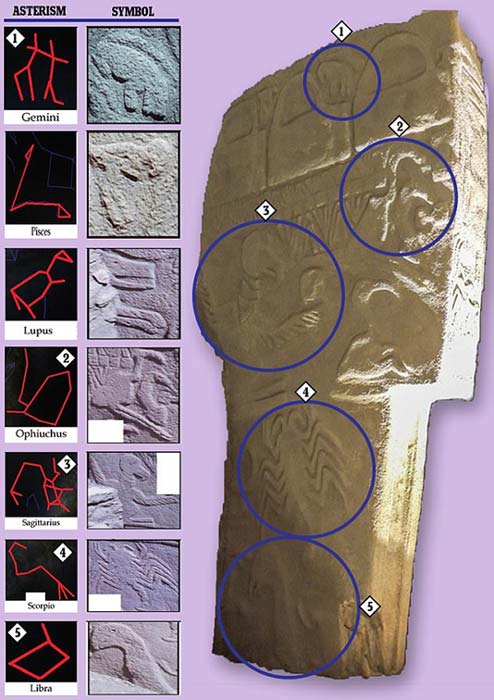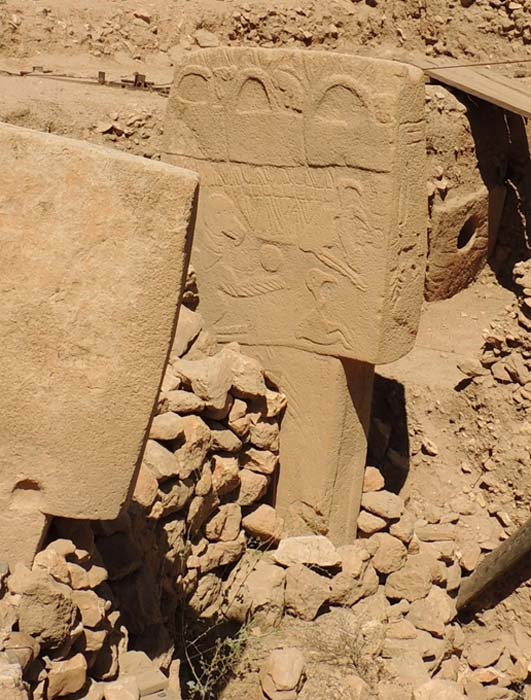Decoding Göbekli Tepe: Secret Society AND Space Observatory?

Research by authors Martin B. Sweatman and Dimitrios Tsikritsis, titled ‘Decoding Göbekli Tepe with archaeoastronomy: What does the fox say?’ published in Mediterranean Archaeology and Archaeometry, vol 17, no. 1. 2017 proposed that a key purpose of the Göbekli Tepe site was to monitor comets and their meteor showers, principally of the Taurid system. They maintain the site was an observatory and that reliefs and symbols on its pillars record events connected with this meteor stream. Pillar 43 of Enclosure D, the puzzling “Tauroctony” of Göbekli Tepe, received focus as a datestamp recording the cometary encounter that has been proposed for causing the Younger Dryas episode.

Reproduction of Göbekli Tepe enclosure D. Credit: Alistair Coombs
The research of Sweatman and Tsikritis clashed with opinions held by the current excavators whose interpretive schemes, following current archaeological trends, prioritise the site as a processor of social complexity and group identity building rather than an observatory. They also claimed, without basis or justification, that constellation mythologies only remained stable for about two thousand years. On a similar note, the fact its structures may have been roofed under pole and thatch for small or longer periods does not prevent sky objects, and ideas about them, entering the mythological world of the builders given the site’s hilltop location. The former head of excavation, Klaus Schmidt, was not personally keen on cultural astronomy but nevertheless made statements conducive to its interpretation.
Temple, Fair House, Observatory
For Schmidt Göbekli Tepe was primarily a sacred site. Its built environment was a nondomestic communal space within a geography of Stone Age pilgrimage, like a sort of amphictyony for hunter-gatherers. Its pillars were non-structural monuments depicting ancestors, gods or supernatural beings. This status of the site as a non-residential sanctuary was challenged by Ted Banning, a specialist in domestic and sacred buildings of the Neolithic Levant. Drawing from a large resource of ethnographic data, he demonstrates the permeability between sacred buildings and residential living spaces. Although he agrees the site had a sacred aspect, Banning believes it was predominately a settlement, that its enclosures were housing units. Absent from the considerations of Schmidt, Banning and others, is the notion of an observatory. An observatory harmonises the house-shrine, sanctuary-settlement dichotomy since, amid other factors, this use of the site would service seasonal gatherings yet accommodate a smaller residence more permanently.
- Göbekli Tepe & The Great Year
- The Secret of Gobekli Tepe: Cosmic Equinox and Sacred Marriage – Part 1
Both Schmidt and Banning compare the humanoid-pillars of Göbekli Tepe to the statues of Easter Island known as moai. Their analogies are limited to the logistics of construction and ambulation and the moai being objects of competitive tribe status. A more qualitative dimension of the moai “images”, however, was to mediate ancestor spirits at astronomically significant times of the year when the statues and their ceremonial centres hosted them. The ancestor spirits otherwise lived in major star groups. Another archaeological feature of Easter Island, less popular than the moai, are its astronomical houses known as tupa. These houses were noted by Katherine Routledge in The Mystery of Easter Island (1919) and in her unpublished writings. As observatories tupas are built on a north-south or east-west axis and occupy key vantage points over the island. Despite their mundane use for starwatching, these buildings combine the secular and supernatural as they were entered by disproportionately narrow entrances to prevent evil spirits gaining access to their interior. Similar rules may have applied at Göbekli Tepe.

Masons hauling a pillar about the size of the Vulture Stone. Credit: Alistair Coombs
Schmidt’s ambitioned way of interpreting the site was to look at it from the Upper Palaeolithic rather than historic periods. Of valuable use here is the research of the archaeologist Brian Hayden who proposes how complex hunter-gatherer groups developed secret societies. This select minority would host seasonally-timed feasts, major ceremonies, and control access to the supernatural realm through ritual at sacred sites (built or natural). Drawing upon decades of research, he suggests deep regions of painted Palaeolithic caves were restricted and used as places of initiation, especially over solstice period festivals. Significantly, he demonstrates how secret society esoterica roots from astronomical monitoring and associated ritual observances, and that core members of these clandestine groups were starwatchers and calendar keepers. In this way, Göbekli Tepe provides an example of hunter-gatherer occultism migrating from cave space to monumental architecture.

Notational belt design on pillar 18 and carved limestone object found at Upper Paleolithic site in Bodrogkeresztur, Hungary identified as a uterus symbol lunar calendar. Credit: Alistair Coombs
Despite architectural dissimilarities across time and space, observatories lack separation between the material and spiritual, they entwine worldly and cosmic domains. Commonly set within symbolic landscapes as with the solstice-orientated sites of Stonehenge and Hopewell, ancient observatories merged with netherworlds. They housed tombs and tunnels reflective of post-mortem journeys, realms which traditionally became more open at specific times of the year.
Hieroglyphs of Nature and the Cosmos
The images that cover Pillar 33 caught Schmidt’s attention in a large way. Located in Enclosure D, the pillar appears more weathered than others and some of its top relief has possibly been modified. Its east-facing side is features cranes, or human-crane combinations, duck-like birds, H symbols and a large bundle of snakes. Its opposite side depicts a fox with an equivalent bundle of snakes. The snakes appear to surge from the fox’s abdomen, as with the cranes on the pillar’s other side. Both sets of snakes turn over the front side of the pillar where their heads synchronise at the sides. The vertical sequence of images found between the snake heads, a combination of animal forms and geometric symbols, struck Schmidt as being a possible script or non-alphabetic system of “hieroglyphs”. The larger animal reliefs, which outnumber the smaller symbol groups on other pillars, he saw as portraying totem-like ideas that were different in meaning to the possible hieroglyphs but representative of the naturalistic resources from which smaller symbols and pictograms of logographic language are formed. Schmidt believed we lacked the syntax for understanding the message of scenes into which symbols and reliefs are grouped, such as pillars 30, 33, 43 and 18.

The pillar depicts a variety of animals. Mediterranean Archaeology and Archaeometry, Vol 17, No.2 (2017). Credit: Alistair Coombs
The vertical sequence of images found between the snake heads, a combination of realistic animal forms and geometric symbols, struck Schmidt as being possible “hieroglyphs” that would have communicated meaning to an observer, especially to those initiated into the ideology of a secret society. In addition to sacred symbols, he saw them as a storage system of knowledge but did not think they were alphabetic in terms of representing a spoken language. The larger reliefs, which outnumber the smaller symbol groups, he saw as totemistic ideas and different in meaning, but representative of the larger naturalistic imagery from which smaller symbols and pictograms of logographic language are formed. Schmidt believed we lacked the syntax for understanding the message of scenes into which symbols and reliefs are grouped, such as pillars 30, 33, 43, and 18.
Whatever story we wish to read from Pillar 33 and how it relates to other reliefs it is clear the artists thought analogically, in that this stone age zoo speaks more than what cranes, foxes and snakes communicate realistically. Sweatman and Tsikritis read some of these figures as referring to the Northern and Southern Taurids. In doing so, they at least propose the carvings to be an ordering of the cosmos: the larger animal reliefs relate to constant constellations and the smaller animals, such as snakes, relate to periods of a year. From this perspective the stock of fauna are not social emblems rooted in the transitory or extemporised art creations but relate to concepts of time or time-factored images of the cosmos.
- Megalithic Origins: Göbekli Tepe and Ancient Peru – The Same Architects?
- Göbekli Tepe Shamans and their Cosmic Symbols – Part I

Do larger reliefs relate to constellations and smaller reliefs and symbols compare to periods of the year and astronomical phenomena? Credit: Alistair Coombs
The Vulture Stone’s Importance
Another important relief in their study is that which covers the west-facing side of Pillar 43, otherwise known as the Vulture Stone. Their reading of this multi-layered iconography suggests the “mortuary ritual” is a metaphor used to mediate a larger cosmic message or, in this case, a climate catstrophe. Rather than describing a state of shamanic ecstasy and ascent, Schmidt interpreted the acephal, ithyphallic condition of the man as someone who had died from violence. Another instance of this would be the bird-man in the Lascaux Shaft scene which some saw as depicting a violent disaster. Banning had proposed the three “boxes” at the top might be Göbekli Tepe houses with corbelled roofs, with the three animals entering them representing social or clan emblems. Given the theme of death and necrophagy, however, these dwellings might be better placed as “charnel houses” of a sort. In support of this reading, the frontside of the pillar shows what Schmidt thought was a Neolithic Kerberos, a hellhound subsequently infamous for ravaging bodies of the dead but also for guarding them. The theme and ensemble of characters bear a significant resemblance to a segment of zodiac of the Barasana hunter-gatherer secret society. This depicts the same region of space the Vulture Stone is thought to.

Asterisms and symbols on the Vulture Stone. Likely depicting the great bustard which can attack snakes and scorpions. Credit: Alistair Coombs / Daily Mail
Concepts of a zodiac or any type of ecliptic system are traditionally not thought to belong to Palaeolithic or even Neolithic times. It has been proposed that specific stars and prominent constellations were rather storied into a Cosmic Hunt narrative based on their motions. Nevertheless, fragments of a zodiac, with figures familiar to us today, do appear on Göbekli Tepe pillars. However one chooses to frame this in a spiritual and mythological context, the formation of a zodiacal map would have optimized the type of annual sky monitoring proposed by Sweatman and Tsikritis.

The Vulture Stone. Credit: Alistair Coombs
Top Image: Artist’s reconstruction of Göbekli Tepe. Source: irmikbune
By Alistair Coombs
References
Banning, E. “So Fair a House: Göbekli Tepe and the Identification of Temples in the Pre-Pottery Neolithic of the Near East.” Current Anthropology, Vol. 52, No. 5, 2011 pp619-60
Berezkin, Yuri, “The Cosmic Hunt: Variants of a Siberian-North American myth.” Archaeology, Ethnology and Anthropology of Eurasia 2, no.22 (2005) 141-50
Hayden, B. And Villeneuve, S. “Astronomy in the Upper Palaeolithic?” Cambridge Archaeological Journal, Vol. 21, No. 3, 2011 pp331-35
Hugh-Jones, S. The Palm and the Pleiades: Initiation and Cosmology in Northwest Amazonia. London: Cambridge University Press, 1979 pp145-6
Marshack, A. The Roots of Civilisation: Cognitive Beginnings of Man’s First Art, Symbol and Notation. New York: McGraw-Hill 1972 pp169-235
Pustovoytov, K. and Taubald, H. “Stable carbon and oxygen isotope composition of pedogenic carbonate at Göbekli Tepe (southeastern Turkey) and its potential for reconstructing Late Quaternary paleoenvironments in upper Mesopotamia.” Neolithics 2/03, 2003 pp25–32
Sandars, N, K. Prehistoric Art in Europe. New Haven: Yale University Press 1995 p128
Schimdt, K. Göbekli Tepe: A Stone Age Sanctuary in South-Eastern Anatolia. Berlin: ex oriente, 2012 pp173-5
Related Post
A shocking documentary proves that mermaids do exist
SHOCKING Revelation: Thuya, Mother of Queen Tiye, Was the Grandmother of Akhenaten and Tutankhamun—What Ancient Egyptian Secrets Did She Leave Behind?
Breaking News: Astonishing Discoveries at Karahan Tepe Confirm an Extraterrestrial Civilization is Hiding on Earth, and NO ONE Knows!
Breaking News: Researchers FINALLY Discover U.S. Navy Flight 19 After 75 Years Lost in the Bermuda Triangle!
NASA’s Secret Investigation: Uncovering the Astonishing Mystery of the UFO Crash on the Mountain!
Explosive UFO Docs LEAKED: Startling Proof That Aliens Ruled Ancient Egypt!